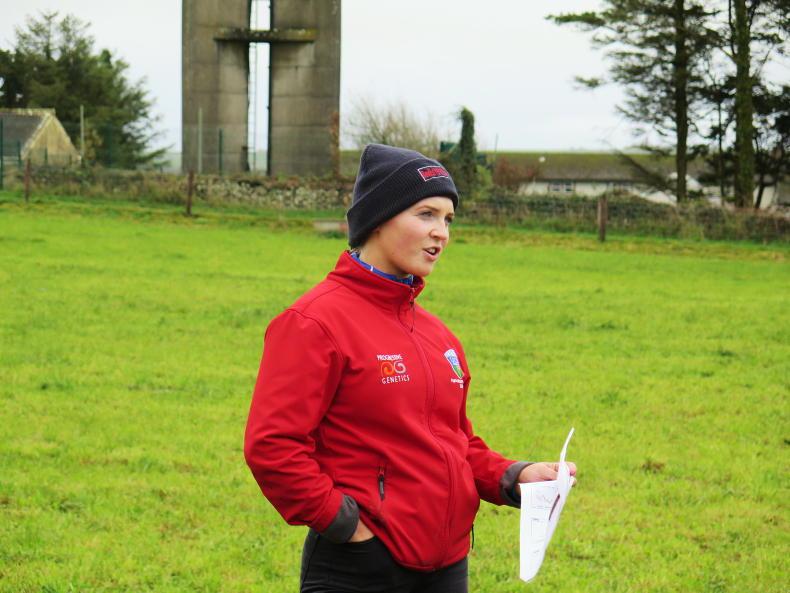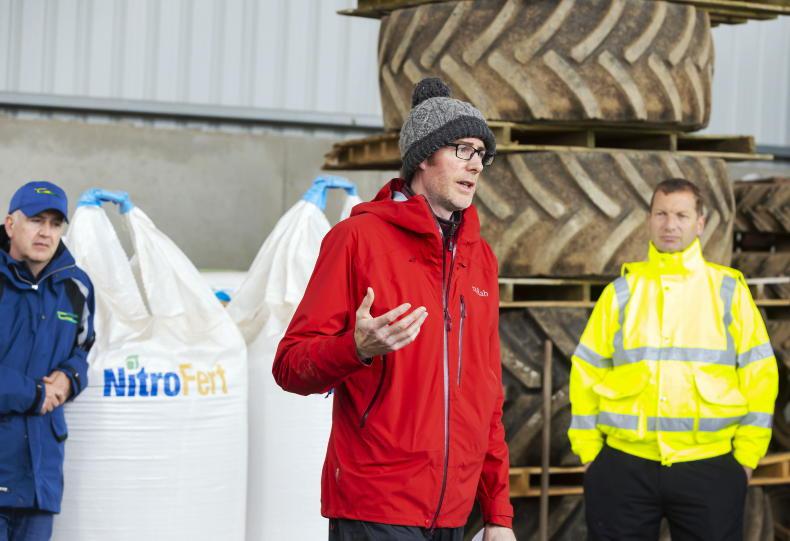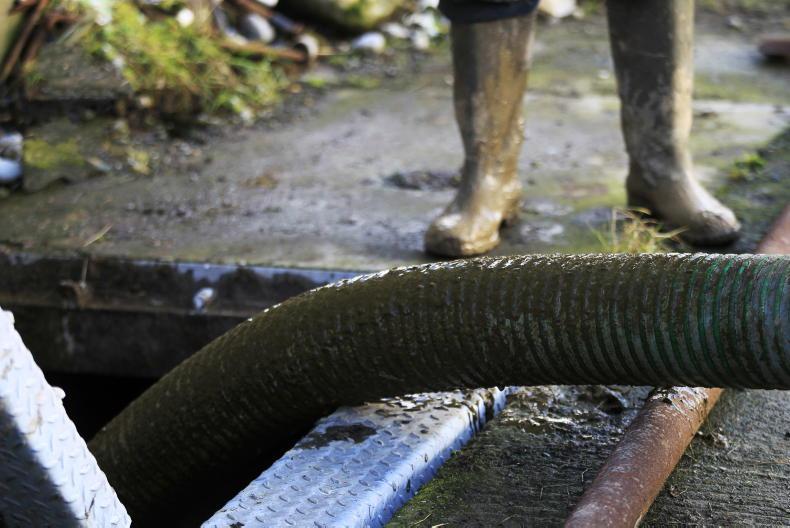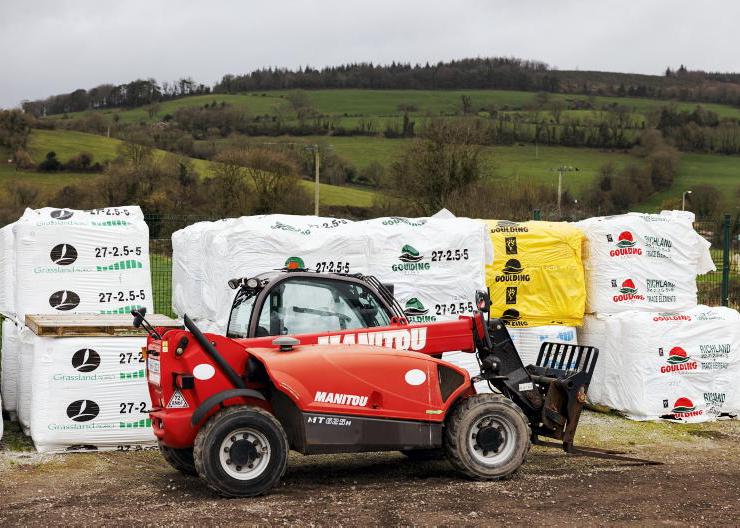A recently published piece of research from Teagasc Moorepark that evaluated three nitrogen fertiliser types across four locations in Ireland has shown that protected urea can reliably produce the same grass growth as CAN fertiliser.
The upside for the environment is there is less ammonia and less greenhouse gas emissions with protected urea.
Although nitrogen fertilisers support high levels of grass dry matter production, they contribute to ammonia and GHG emissions under Irish grazing conditions. Nitrogen fertilisers can be a major contributor to ammonia emissions (mainly from standard urea fertilisers) and to GHG emissions in the form of nitrous oxide (N2O) losses (mainly CAN-based fertilisers).
The Irish Government has set a target to reduce total GHG emissions by 51% by 2030, and agricultural GHG emissions by 25% compared to the baseline year of 2018.
The simplest and most effective way available to farmers to contribute to achieving some of these reductions is by switching their straight nitrogen fertiliser use to a protected urea form. Given the current price differential between CAN and protected urea such a change would also save farmers money.
Protected urea is standard urea that has been coated with a urease inhibitor to reduce ammonia emissions.
Currently, NBPT, NPPT+NBPT and 2-NPT are registered urease inhibitors under the EU fertiliser regulations with minimum and maximum levels at the point of sale specified.
These urease inhibitors reduce ammonia volatilisation from urea by mimicking urea and blocking the active site of the urease enzyme resulting in more nitrogen being retained for grass growth.

Áine Murray is doing her PhD on clover in Clonakilty.
Previous research from Johnstown Castle has shown that there was no difference in grass DM production between CAN, NBPT-urea and urea under a cutting regime (five to six cuts per year) despite finding that NBPT-urea reduced ammonia losses compared to urea by 79% and nitrous oxide emissions by 71% compared to CAN.

Teagasc Signpost Farm walk on John Crowley's farm, Ferns, Co Wexford. Pictured speaking is Teagasc’s Patrick Forrestal, soil researcher. \ Patrick Browne
Environmental benefits
Despite the clear environmental benefits of protected urea in terms of hitting agriculture’s emissions reduction targets, the uptake of protected urea usage on farms has been relatively slow.
This slow uptake has been due to issues such as availability, concerns over the storage of protected urea and concerns over the grass growth of swards fertilised with protected urea compared to CAN.

Brian McCarthy, Teagasc. \ Donal O'Leary
In terms of the storage issue, once the urea granules have been coated with the protection a slow process of inhibitor degradation will initiate but this does not affect the urea or nitrogen content of the fertiliser.
The Department of Agriculture check that the registered urease inhibitors mentioned above meet the minimum specification at the point of sale.
A plot grazing study was set up to compare the grass DM production of swards fertilised with CAN, protected urea and urea under rotational grazing at a number of locations across Ireland.
In 2019, plots were established in Moorepark and Clonakilty Agricultural College, with additional sites added in 2020 in Athenry and Ballyhaise.
Plots were grazed by dairy cows in Moorepark, Clonakilty and Ballyhaise and by sheep in Athenry.
The study ran until the end of 2021 with three years of data collected in Moorepark and Clonakilty and two years of data collected in Athenry and Ballyhaise.

Áine Murray compares the difference in growth between protected urea, CAN and urea for the Sustainable Milk Production Systems village at Moorepark 2019 Open Day. \ Donal O'Leary
CAN, urea and protected urea (NBPT-urea was the form of protected urea used in the study) fertilisers were compared at two fertiliser rates, 150kg N/ha and 250kg N/ha annually.
The CAN, NBPT-urea and urea used for the study was bought at the beginning of each year of the study and used for the full growing season of each year.
Fertiliser was applied in late January/early February each year and was then applied after each grazing. Plots were grazed in March, early April and thereafter on an approximate 21-day rotation when the control plots reached a pre-grazing herbage yield of 1,500kg DM/ha.
Prior to grazing, plots were sampled for pre-grazing herbage yield, pre-grazing height and crude protein content.
The response to N fertiliser type and N fertiliser rate was similar at all four locations. The average results for all locations and years is presented in Table 1.
There was no difference between CAN and NBPT-urea in terms of pre-grazing herbage yield (1,485kg and 1,480kg DM/ha, respectively) but pre-grazing herbage yield was slightly lower for urea (1,436kg DM/ha).
Figure 1 shows the average pre-grazing herbage yield for each fertiliser type by rotation for all locations and years. There was some variation within rotation between fertiliser types but the differences were small and as shown earlier, there was no difference between CAN and NBPT-urea.
Fertiliser type didn’t have any effect on pre-grazing sward height or post-grazing sward height or sward crude protein content.
Within the individual locations, there was no difference between fertiliser types in terms of total grass production (Table 1).
However, when all the data was combined and looked at across all locations and years, total herbage production was significantly higher for CAN and NBPT-urea (13,478kg and 13,542kg DM/ha, respectively) compared to urea (13,087kg DM/ha).
As expected, the 250 kg N/ha treatments had higher pre-grazing herbage yield (1,588kg DM/ha) and total grass production (14,448kg DM/ha) than the 150kg N/ha treatments (1,346kg DM/ha for pre-grazing herbage yield and 12,290kg DM/ha for total grass production).
In conclusion, at all locations over the course of the study, grass growth was consistently similar between NBPT-urea and CAN, with no differences observed in overall total herbage production. There was an overall benefit in herbage production (+ 424kg DM/ha) from using urea protected with NBPT compared to using standard urea.
The results from this study show that farmers should have confidence in using protected urea to achieve high DM production while helping to reduce nitrogen losses to the environment.
A recently published piece of research from Teagasc Moorepark that evaluated three nitrogen fertiliser types across four locations in Ireland has shown that protected urea can reliably produce the same grass growth as CAN fertiliser.
The upside for the environment is there is less ammonia and less greenhouse gas emissions with protected urea.
Although nitrogen fertilisers support high levels of grass dry matter production, they contribute to ammonia and GHG emissions under Irish grazing conditions. Nitrogen fertilisers can be a major contributor to ammonia emissions (mainly from standard urea fertilisers) and to GHG emissions in the form of nitrous oxide (N2O) losses (mainly CAN-based fertilisers).
The Irish Government has set a target to reduce total GHG emissions by 51% by 2030, and agricultural GHG emissions by 25% compared to the baseline year of 2018.
The simplest and most effective way available to farmers to contribute to achieving some of these reductions is by switching their straight nitrogen fertiliser use to a protected urea form. Given the current price differential between CAN and protected urea such a change would also save farmers money.
Protected urea is standard urea that has been coated with a urease inhibitor to reduce ammonia emissions.
Currently, NBPT, NPPT+NBPT and 2-NPT are registered urease inhibitors under the EU fertiliser regulations with minimum and maximum levels at the point of sale specified.
These urease inhibitors reduce ammonia volatilisation from urea by mimicking urea and blocking the active site of the urease enzyme resulting in more nitrogen being retained for grass growth.

Áine Murray is doing her PhD on clover in Clonakilty.
Previous research from Johnstown Castle has shown that there was no difference in grass DM production between CAN, NBPT-urea and urea under a cutting regime (five to six cuts per year) despite finding that NBPT-urea reduced ammonia losses compared to urea by 79% and nitrous oxide emissions by 71% compared to CAN.

Teagasc Signpost Farm walk on John Crowley's farm, Ferns, Co Wexford. Pictured speaking is Teagasc’s Patrick Forrestal, soil researcher. \ Patrick Browne
Environmental benefits
Despite the clear environmental benefits of protected urea in terms of hitting agriculture’s emissions reduction targets, the uptake of protected urea usage on farms has been relatively slow.
This slow uptake has been due to issues such as availability, concerns over the storage of protected urea and concerns over the grass growth of swards fertilised with protected urea compared to CAN.

Brian McCarthy, Teagasc. \ Donal O'Leary
In terms of the storage issue, once the urea granules have been coated with the protection a slow process of inhibitor degradation will initiate but this does not affect the urea or nitrogen content of the fertiliser.
The Department of Agriculture check that the registered urease inhibitors mentioned above meet the minimum specification at the point of sale.
A plot grazing study was set up to compare the grass DM production of swards fertilised with CAN, protected urea and urea under rotational grazing at a number of locations across Ireland.
In 2019, plots were established in Moorepark and Clonakilty Agricultural College, with additional sites added in 2020 in Athenry and Ballyhaise.
Plots were grazed by dairy cows in Moorepark, Clonakilty and Ballyhaise and by sheep in Athenry.
The study ran until the end of 2021 with three years of data collected in Moorepark and Clonakilty and two years of data collected in Athenry and Ballyhaise.

Áine Murray compares the difference in growth between protected urea, CAN and urea for the Sustainable Milk Production Systems village at Moorepark 2019 Open Day. \ Donal O'Leary
CAN, urea and protected urea (NBPT-urea was the form of protected urea used in the study) fertilisers were compared at two fertiliser rates, 150kg N/ha and 250kg N/ha annually.
The CAN, NBPT-urea and urea used for the study was bought at the beginning of each year of the study and used for the full growing season of each year.
Fertiliser was applied in late January/early February each year and was then applied after each grazing. Plots were grazed in March, early April and thereafter on an approximate 21-day rotation when the control plots reached a pre-grazing herbage yield of 1,500kg DM/ha.
Prior to grazing, plots were sampled for pre-grazing herbage yield, pre-grazing height and crude protein content.
The response to N fertiliser type and N fertiliser rate was similar at all four locations. The average results for all locations and years is presented in Table 1.
There was no difference between CAN and NBPT-urea in terms of pre-grazing herbage yield (1,485kg and 1,480kg DM/ha, respectively) but pre-grazing herbage yield was slightly lower for urea (1,436kg DM/ha).
Figure 1 shows the average pre-grazing herbage yield for each fertiliser type by rotation for all locations and years. There was some variation within rotation between fertiliser types but the differences were small and as shown earlier, there was no difference between CAN and NBPT-urea.
Fertiliser type didn’t have any effect on pre-grazing sward height or post-grazing sward height or sward crude protein content.
Within the individual locations, there was no difference between fertiliser types in terms of total grass production (Table 1).
However, when all the data was combined and looked at across all locations and years, total herbage production was significantly higher for CAN and NBPT-urea (13,478kg and 13,542kg DM/ha, respectively) compared to urea (13,087kg DM/ha).
As expected, the 250 kg N/ha treatments had higher pre-grazing herbage yield (1,588kg DM/ha) and total grass production (14,448kg DM/ha) than the 150kg N/ha treatments (1,346kg DM/ha for pre-grazing herbage yield and 12,290kg DM/ha for total grass production).
In conclusion, at all locations over the course of the study, grass growth was consistently similar between NBPT-urea and CAN, with no differences observed in overall total herbage production. There was an overall benefit in herbage production (+ 424kg DM/ha) from using urea protected with NBPT compared to using standard urea.
The results from this study show that farmers should have confidence in using protected urea to achieve high DM production while helping to reduce nitrogen losses to the environment.














SHARING OPTIONS